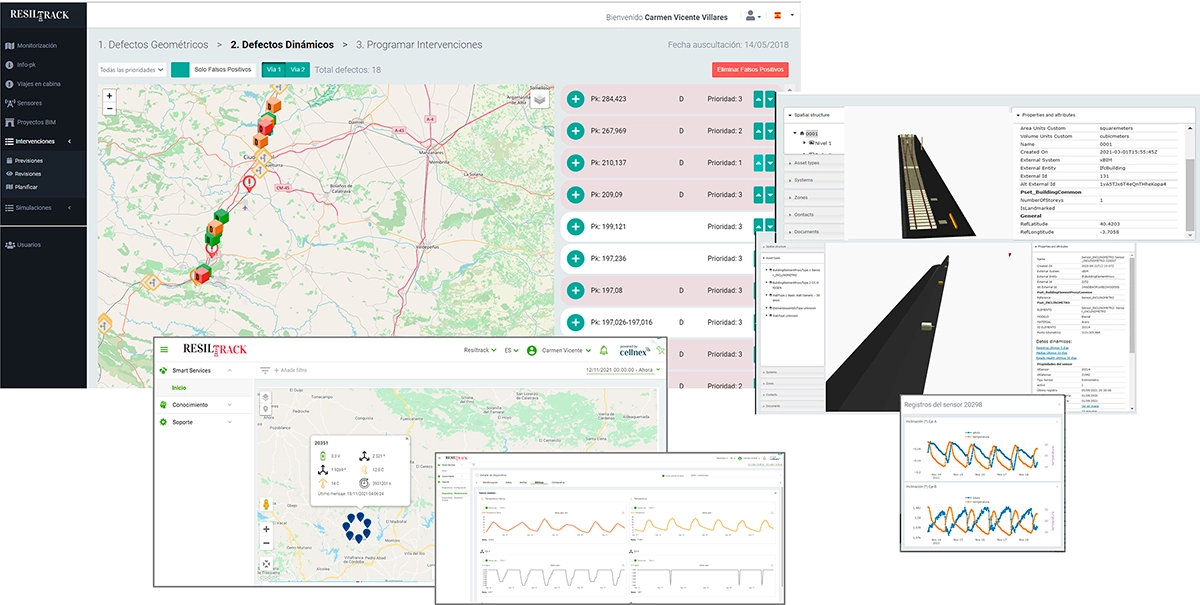Trends
Trends
DEC
28
2021
Transports & Logistics
Internet of Things to digitalise train lines
Backpack in hand, I board the train in Madrid that will take me to Barcelona. The 650Km journey, between eight- and nine-hours long before arrival of the AVE high-speed train, now takes about two and a half hours. It is amazing how high speeds shorten distances! With the new Hyperloop technology, it is estimated that journeys like Madrid-Paris, two cities which are 1,300 km apart, could take one hour!
As I take in the landscape from my seat beside the window, it strikes me that high-speed travel and increasingly short journeys –one can almost speak of “teleportation”– are at the forefront of user-oriented innovations in the service. But… are there more options for innovation in the railway sector?
Of course! High speeds can be attained if trains run on infrastructure that is in good condition.
For that reason, observing and monitoring elements like tracks, catenaries, bridges, tunnels, drainage works and retaining walls is essential to facilitating services on railway corridors.
Innovation to guarantee the quality and safety of train service
In Spain alone, the railway network is made up of almost 16,000 km of track, 3,100 km of which is for high-speed trains.
Many of these tracks run through remote and hard to access locations, making it difficult to gauge the actual state of the infrastructure and perform effective maintenance to prevent disruptions in the train service or mitigate the impact of such disruptions, should they occur.
Maintenance on railway lines typically focuses on corrective tasks and resolving incidents which prevent train services from running correctly. This is combined with preventive maintenance, which is planned based on historical data and estimates about the useful life of railway infrastructure components. There are also trains that collect data en route — data which, on arrival at stations, are downloaded, processed and analysed to improve historical data-based estimates.
Furthermore, weather conditions impact the state of railway infrastructure. The meteorological effects of wind, rain, snow and high temperatures directly affect rail track components and train services as well.
It is precisely in the monitoring and preventive maintenance of railway infrastructure that innovation plays an important role in enhancing the quality and safety of railway lines by preventing accidents of all types.
Thanks to the application of technologies like the Internet of Things (IoT), Big Data, Artificial Intelligence, BIM (Building Information Modeling), Digital Twin, etc., maintenance of railway infrastructure can become much more accurate, optimal and efficient by going from corrective to preventive in real time. These technologies make it possible to create more precise behaviour patterns, which increase the accuracy of predictions about trains, meteorological effects and infrastructure degradation over time.
RESILTRACK, synonymous with digital railway transformation
RESILTRACK is an example of railway infrastructure digitalisation that is aimed at gauging the state of the railway infrastructure and the impact of adverse climatic phenomena, with an innovative solution that allows us to obtain data in real time.
To that end, RESILTRACK uses a network of sensors to measure a diverse array of parameters including vibrations, grades, accelerations, etc. which, together with climatological and environmental data, help to determine the state of the distinct components of the railway infrastructure.
IoT connectivity solutions allow connections to be made between sensors in pilot areas and the SmartBrain data integrator platform. For example, this makes it possible to monitor infrastructure on the conventional train line in Porqueros (Leon), on the AVE high-speed line in Adamuz (Córdoba) and along the Calatrava-Puertollano section (Ciudad Real).
The SmartBrain platform collects data in real time from the network of sensors, scans them for outliers and issues early warnings which activate maintenance services. Moreover, values and alerts are recorded and incorporated into the Big Data repository so that artificial intelligence services can process them and extract valuable information, from which behaviour patterns are generated to help estimate responses to various situations.
RESILTRACK offers a web application environment where railway infrastructure managers can monitor incidents in real time, run simulations, manage alerts and use BIM tools to visualize the state of infrastructure.
In this way, RESILTRACK facilitates decision-making which helps improve preventive maintenance by averting or mitigating incidents, accidents and disruptions in train line services and guaranteeing proper service quality.
Teamwork
Cellnex participates in the project in partnership with a consortium of companies (COMSA, Cemosa, Estudios GIS, Magtel, Telice, TPF) and research centres (CIMNE, LEITAT, Tecnalia and the University of Malaga). The COMSA-led consortium is supported by ADIF, which has provided its infrastructures to implement and validate RESILTRACK solutions in a real environment.
Cellnex is the reference ICT partner of the project, furnishing the SmartBrain data integration platform and IoT communications solutions that provide LoRA coverage to the pilot areas.
The RESILTRACK project is funded by the CDTI’s CIEN 2017 Strategic Programme, with reference number IDI-20171003.
Carmen Vicente
Cellnex Innovation Project Manager



















